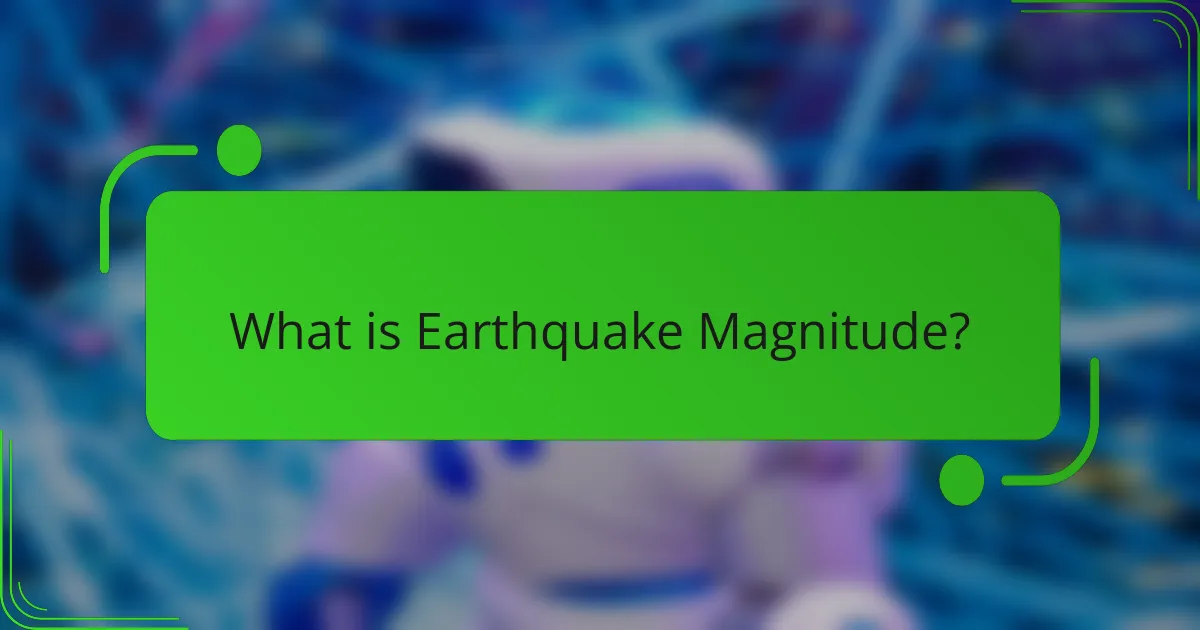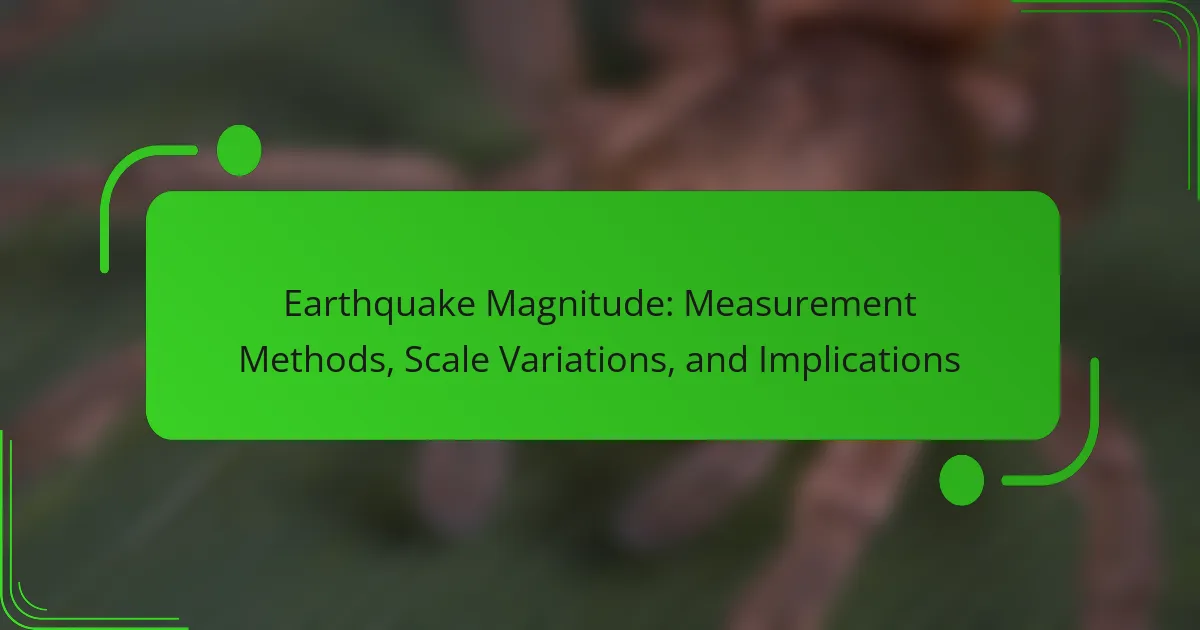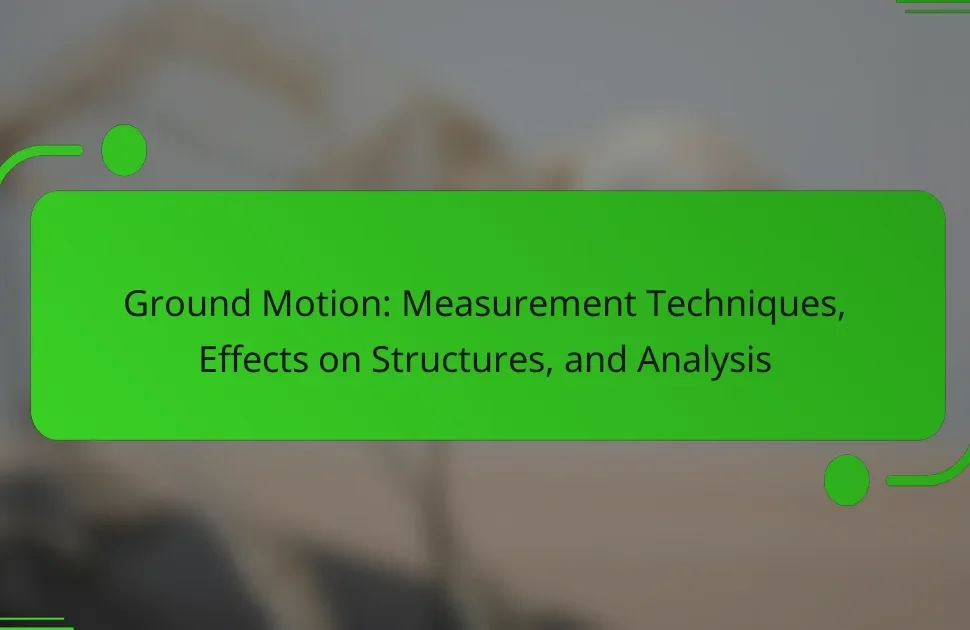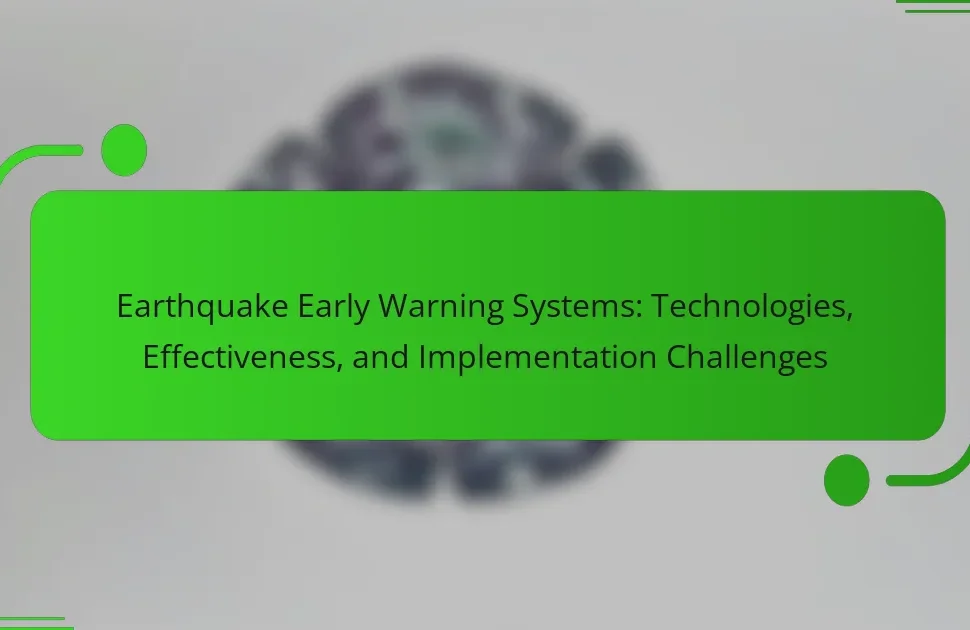Earthquake magnitude is a numerical measurement that quantifies the energy released during a seismic event, primarily assessed using the Richter scale and the Moment Magnitude scale. This measurement is crucial for understanding the potential impact of earthquakes, as higher magnitudes correlate with increased destruction and loss of life. The article will explore the implications of earthquake magnitude on building codes, emergency preparedness, and risk assessment, while also addressing the challenges associated with accurately measuring magnitude due to factors such as geological conditions and the choice of measurement scales. Understanding these aspects is essential for effective disaster planning and response strategies.

What is Earthquake Magnitude?
Earthquake magnitude is a numerical measurement of the energy released during an earthquake. It quantifies the size of the seismic event. The most common scale used is the Richter scale. This scale measures the amplitude of seismic waves. Each whole number increase on the Richter scale represents a tenfold increase in measured amplitude. Additionally, it corresponds to approximately 31.6 times more energy release. Other scales, like the Moment Magnitude scale, are also used for larger earthquakes. These scales provide a more accurate assessment of significant seismic events.
How is Earthquake Magnitude defined?
Earthquake magnitude is defined as a measure of the energy released during an earthquake. It quantifies the size of the seismic event on a logarithmic scale. The most commonly used scale is the Richter scale, developed in 1935. This scale measures seismic waves’ amplitude and accounts for the distance from the earthquake’s epicenter. Each whole number increase on the Richter scale represents a tenfold increase in measured amplitude. For example, a magnitude 6 earthquake releases approximately 31.6 times more energy than a magnitude 5 earthquake. Other scales, such as the Moment Magnitude Scale (Mw), are also used for larger earthquakes. The Moment Magnitude Scale provides a more accurate measurement for very large seismic events.
What are the key characteristics of Earthquake Magnitude?
Earthquake magnitude is a measure of the energy released during an earthquake. It is quantified using various scales, primarily the Richter scale and the moment magnitude scale (Mw). The Richter scale measures the amplitude of seismic waves. The moment magnitude scale accounts for the fault area and slip, providing a more accurate measurement for larger quakes. Magnitude values are logarithmic, meaning each whole number increase represents a tenfold increase in amplitude. The magnitude scale typically ranges from 0 to 10. Earthquakes with a magnitude of 2.0 or lower are generally not felt. A magnitude of 4.0 to 4.9 is considered light, while 5.0 to 5.9 is moderate. Major earthquakes usually have a magnitude of 7.0 or higher, causing significant damage.
Why is Earthquake Magnitude important in seismology?
Earthquake magnitude is crucial in seismology because it quantifies the energy released during an earthquake. This measurement helps scientists assess the earthquake’s potential impact. Magnitude scales, such as the Richter scale and moment magnitude scale, provide standardized values for comparison. Accurate magnitude readings inform emergency response efforts and public safety measures. Historical data shows that larger magnitudes correlate with more severe damage. For example, the 2010 Haiti earthquake had a magnitude of 7.0, resulting in significant destruction and loss of life. Understanding magnitude aids in risk assessment and preparedness for future seismic events.
What are the different scales used to measure Earthquake Magnitude?
The different scales used to measure earthquake magnitude include the Richter scale, the Moment Magnitude scale, and the Modified Mercalli Intensity scale. The Richter scale quantifies the amplitude of seismic waves. It was developed in 1935 by Charles F. Richter. The Moment Magnitude scale measures the total energy released by an earthquake. It is considered more accurate for large quakes. The Modified Mercalli Intensity scale assesses the effects of an earthquake on people and structures. It ranges from I (not felt) to XII (total destruction). Each scale serves a different purpose in understanding earthquakes.
How does the Richter scale measure Earthquake Magnitude?
The Richter scale measures earthquake magnitude by quantifying the amplitude of seismic waves. It uses data from seismographs to assess the energy released during an earthquake. Each whole number increase on the scale represents a tenfold increase in measured amplitude. For example, a magnitude 5 earthquake produces seismic waves with amplitudes ten times greater than a magnitude 4 earthquake. The scale is logarithmic, which means it also reflects a 31.6 times increase in energy release with each whole number increase. Developed by Charles F. Richter in 1935, this scale provides a standardized way to compare the size of earthquakes. The Richter scale is most effective for measuring small to medium-sized earthquakes. However, it may not accurately represent larger earthquakes, where other scales like the moment magnitude scale are preferred.
What is the Moment Magnitude scale and how does it differ?
The Moment Magnitude scale measures the size of earthquakes based on seismic moment. It quantifies the energy released during an earthquake. This scale differs from the Richter scale, which measures amplitude of seismic waves. The Moment Magnitude scale is more accurate for large earthquakes. It accounts for the area of the fault that slipped and the amount of slip. This scale provides a consistent measure across different regions and distances. Research shows that the Moment Magnitude scale is preferred by seismologists for its reliability.
What factors influence the measurement of Earthquake Magnitude?
The measurement of earthquake magnitude is influenced by several key factors. The primary factor is the amplitude of seismic waves recorded by seismographs. Larger amplitudes indicate stronger earthquakes. Another factor is the distance from the seismograph to the earthquake’s epicenter. This distance affects the recorded wave amplitude. The type of seismic waves, such as P-waves and S-waves, also plays a role in magnitude calculation. The geological characteristics of the area, including rock type and fault mechanics, can influence wave propagation. Furthermore, the depth of the earthquake affects the magnitude measurement. Shallower earthquakes typically produce stronger surface shaking. Lastly, the calibration of the seismograph equipment is crucial for accurate readings. These factors collectively determine the magnitude value reported by seismologists.
How do geological conditions affect Earthquake Magnitude readings?
Geological conditions significantly influence Earthquake Magnitude readings. The type of geological material affects seismic wave propagation. For example, seismic waves travel faster through solid rock than through softer sediments. This difference can result in varying magnitude readings for the same earthquake event depending on the geological context. Additionally, the depth of the earthquake’s focus can alter the perceived magnitude. Shallow earthquakes often produce stronger surface shaking than deeper ones, leading to higher magnitude readings. Geological structures, such as fault lines, also impact how energy is released during an earthquake. These conditions collectively determine the magnitude readings recorded by seismographs.
What role do seismic waves play in determining Earthquake Magnitude?
Seismic waves play a crucial role in determining earthquake magnitude. They are generated by the sudden release of energy in the Earth’s crust during an earthquake. The strength and amplitude of these waves are measured by seismographs. The most common scales used, such as the Richter scale and the moment magnitude scale, rely on seismic wave data. The moment magnitude scale, for example, calculates magnitude based on the seismic moment, which includes the area of the fault and the amount of slip. Higher amplitude seismic waves indicate larger earthquakes. The duration of seismic waves also contributes to magnitude assessment. Overall, seismic waves provide essential data for accurately measuring and understanding earthquake magnitude.

What are the implications of Earthquake Magnitude?
Earthquake magnitude has significant implications for understanding the potential impact of seismic events. It quantifies the energy released during an earthquake, which correlates with the potential for damage. Higher magnitude earthquakes generally result in greater destruction and loss of life. For example, a magnitude 7.0 earthquake can cause severe damage in populated areas, while a magnitude 9.0 earthquake can lead to catastrophic consequences over vast regions.
Magnitude also influences building codes and emergency response strategies. Areas prone to higher magnitude earthquakes typically implement stricter building regulations to mitigate risks. Emergency preparedness plans are often tailored based on the expected magnitude of seismic events. Historical data shows that magnitude is a critical factor in assessing risk and planning for disaster recovery.
In summary, earthquake magnitude directly affects damage potential, safety regulations, and emergency preparedness.
How does Earthquake Magnitude impact public safety?
Earthquake magnitude significantly impacts public safety by determining the potential damage and risk to life. Higher magnitude earthquakes, such as those above 6.0 on the Richter scale, can cause severe structural damage and pose a greater threat to human safety. For instance, the 2010 Haiti earthquake, which measured 7.0, resulted in over 230,000 fatalities and widespread destruction. In contrast, lower magnitude earthquakes, typically below 4.0, often go unnoticed and cause minimal damage. Emergency response planning is heavily influenced by the magnitude, as higher magnitudes require more extensive resources and quicker mobilization. The ability to assess magnitude accurately allows authorities to issue timely warnings and evacuations, thereby enhancing public safety.
What measures can communities take based on Earthquake Magnitude?
Communities can implement specific measures based on earthquake magnitude to enhance safety and preparedness. For minor earthquakes (magnitude 2.0-3.9), communities should educate residents on earthquake safety and encourage the securing of heavy furniture. For moderate earthquakes (magnitude 4.0-5.9), local governments should conduct drills and establish emergency response plans. For strong earthquakes (magnitude 6.0-6.9), communities must ensure building codes are enforced and retrofitting of older structures is prioritized. For major earthquakes (magnitude 7.0-7.9), comprehensive evacuation plans should be developed, and emergency services need to be adequately equipped. For great earthquakes (magnitude 8.0 and above), communities should establish regional coordination for disaster response and recovery, including mutual aid agreements with neighboring areas. Historical data shows that effective preparedness reduces casualties and property damage significantly. For instance, the 2010 Haiti earthquake highlighted the catastrophic impact of inadequate measures in high-magnitude events.
How can Earthquake Magnitude inform emergency response strategies?
Earthquake magnitude informs emergency response strategies by indicating the potential severity of an earthquake. Higher magnitude values suggest stronger earthquakes, which typically result in more significant damage and higher casualties. For instance, a magnitude 6.0 earthquake can cause moderate damage, while a magnitude 7.0 or higher can lead to severe destruction. Emergency responders utilize magnitude data to prioritize resources and deploy teams to the most affected areas first. This data also aids in public safety messaging, informing residents of the expected impact. Historical data shows that effective response strategies are linked to accurate magnitude assessments. The 2010 Haiti earthquake, with a magnitude of 7.0, exemplified the need for swift international aid due to its devastating effects. Thus, understanding earthquake magnitude is crucial for timely and effective emergency management.
What are the economic implications of Earthquake Magnitude?
The economic implications of earthquake magnitude are significant and multifaceted. Higher magnitude earthquakes typically result in greater damage to infrastructure and property. For instance, a magnitude 7.0 earthquake can cause losses in the billions of dollars. Economic disruption includes costs related to emergency response, recovery, and rebuilding efforts. Regions affected by higher magnitude earthquakes often experience long-term economic decline. This decline can stem from population displacement and reduced business activity. Insurance claims increase substantially following larger quakes, impacting the insurance industry. Additionally, the economic impact extends to local businesses, which may suffer from decreased consumer spending. Historical data shows that the 1994 Northridge earthquake caused an estimated $44 billion in damages, illustrating the severe economic consequences of high-magnitude events.
How does Earthquake Magnitude affect insurance and recovery costs?
Earthquake magnitude significantly influences insurance and recovery costs. Higher magnitude earthquakes typically result in more extensive damage. This increased damage leads to higher claims filed with insurance companies. For example, a magnitude 7.0 earthquake can cause billions in damage, compared to a 5.0 magnitude quake. Insurance premiums often rise in areas prone to higher magnitude quakes. Recovery costs also escalate due to the need for more extensive rebuilding and infrastructure repair. Studies show that recovery from a major earthquake can take years, impacting local economies. Thus, the magnitude of an earthquake directly correlates with financial implications for insurance and recovery efforts.
What is the relationship between Earthquake Magnitude and infrastructure damage?
Earthquake magnitude directly correlates with infrastructure damage. Higher magnitude earthquakes typically produce more intense shaking. This shaking can lead to structural failure in buildings and bridges. For instance, earthquakes with a magnitude of 6.0 or higher often cause significant damage. Studies show that a magnitude 7.0 earthquake can result in catastrophic destruction in urban areas. The 2010 Haiti earthquake, with a magnitude of 7.0, caused extensive infrastructure collapse. Conversely, lower magnitude earthquakes may cause minimal or no damage. Thus, the relationship is clear: as earthquake magnitude increases, the potential for infrastructure damage also increases.
How does Earthquake Magnitude influence scientific research?
Earthquake magnitude significantly influences scientific research by determining the scale of seismic events. Researchers use magnitude to assess the potential impact of earthquakes on structures and populations. Higher magnitude earthquakes typically correlate with increased damage and risk. This information guides emergency preparedness and response strategies. Magnitude also aids in understanding tectonic processes and predicting future seismic activity. Studies often focus on the relationship between magnitude and aftershock patterns. For example, the moment magnitude scale provides a more accurate measure for larger earthquakes. This precision enhances data collection and analysis in seismology.
What advancements in technology have improved Earthquake Magnitude measurement?
Advancements in technology have significantly improved earthquake magnitude measurement. Modern seismometers now use digital technology for enhanced precision. These instruments can detect minute ground movements. Advanced algorithms analyze seismic data in real time. This allows for quicker and more accurate magnitude calculations. Satellite technology also contributes by providing data on ground deformation. This information helps to assess earthquake impacts more effectively. Additionally, networks of sensors offer comprehensive coverage of seismic activity. These improvements have led to better preparedness and response strategies for earthquakes.
How does understanding Earthquake Magnitude contribute to earthquake prediction?
Understanding earthquake magnitude aids in earthquake prediction by providing a quantitative measure of an earthquake’s size. This measurement helps seismologists assess potential damage and the likelihood of aftershocks. Magnitude scales, such as the Richter scale, categorize earthquakes based on their energy release. Accurate magnitude assessments allow for improved risk assessment in seismically active areas. Historical data shows that larger magnitude earthquakes are more likely to produce significant aftershocks. For instance, the 2010 Haiti earthquake had a magnitude of 7.0, leading to numerous aftershocks that were predicted based on its initial magnitude. Thus, understanding magnitude is crucial for developing effective early warning systems and public safety measures.

What are the challenges in measuring Earthquake Magnitude?
Measuring earthquake magnitude presents several challenges. One challenge is the variability in seismic wave propagation. Different geological conditions affect how seismic waves travel, leading to discrepancies in measurements. Another challenge is the choice of magnitude scale. Various scales, such as Richter and moment magnitude, can yield different results for the same event. Additionally, the depth of the earthquake influences the magnitude reading. Shallow earthquakes may be recorded differently than deeper ones. The location of seismic stations also affects accuracy. Stations farther from the epicenter may capture weaker signals, resulting in underestimation. Finally, human error in data interpretation can lead to inaccuracies. These factors combined complicate the consistent measurement of earthquake magnitude.
What limitations exist in current measurement methods?
Current measurement methods for earthquake magnitude have several limitations. One limitation is the reliance on seismic waves, which can vary significantly in speed and amplitude. This variability affects the accuracy of magnitude calculations. Additionally, different scales, such as the Richter and Moment Magnitude scales, can yield different results for the same event. This inconsistency complicates comparisons across regions and time periods. Another limitation is the dependence on local seismic networks, which may not be uniformly distributed. Areas with fewer stations may have less reliable data. Furthermore, measurement methods often struggle with very small or very large earthquakes, where data may be insufficient or overly complex. These limitations highlight the challenges in achieving precise and consistent earthquake magnitude assessments.
How do discrepancies in measurements occur among different scales?
Discrepancies in measurements occur among different scales due to variations in the methodologies used for calculating earthquake magnitudes. Each scale, such as the Richter scale or the Moment Magnitude scale, applies distinct formulas and parameters. The Richter scale primarily measures the amplitude of seismic waves, while the Moment Magnitude scale considers the fault’s area and the amount of slip during an earthquake.
This difference in approach leads to variations in reported magnitudes for the same seismic event. Additionally, factors like the distance from the seismic station and local geological conditions can influence measurements. For instance, the Richter scale may underestimate magnitudes for very large earthquakes, while the Moment Magnitude scale provides a more consistent measurement across a wide range of magnitudes.
Research has shown that discrepancies can be significant, particularly for large earthquakes. A study by Hanks and Bakun (2002) highlights how different scales can yield varying results, emphasizing the importance of using the appropriate scale for accurate earthquake assessment.
What challenges arise in remote or inaccessible areas?
Remote or inaccessible areas face significant challenges during earthquakes. Limited infrastructure hampers immediate response efforts. Communication systems are often unreliable or nonexistent. This isolation makes it difficult to assess damage and provide aid. Transportation routes may be blocked or damaged, complicating rescue missions. Additionally, local populations may lack preparedness and resources. These factors can lead to higher casualties and prolonged recovery times. Studies show that effective response is critical in these regions, as highlighted by the 2010 Haiti earthquake, where access issues exacerbated the disaster’s impact.
What are the future directions for Earthquake Magnitude research?
Future directions for earthquake magnitude research include the development of more precise measurement techniques. Enhanced technology can improve the accuracy of magnitude calculations. Researchers are focusing on integrating machine learning algorithms for real-time data analysis. This approach could lead to faster and more reliable earthquake assessments. Another direction involves studying the relationship between magnitude and seismic impact. Understanding this connection can improve risk assessment models. Additionally, there is an emphasis on global collaboration for data sharing. This can enhance the understanding of seismic activity across different regions. Finally, ongoing research aims to refine existing magnitude scales for better applicability. These advancements will contribute to more effective earthquake preparedness and response strategies.
How might new technologies change the way we measure Earthquake Magnitude?
New technologies may enhance the measurement of earthquake magnitude through improved sensor accuracy and data analysis. Advanced seismic sensors can detect smaller tremors that traditional methods might miss. These sensors provide real-time data, allowing for immediate magnitude calculations. Machine learning algorithms can analyze seismic data more efficiently than human analysts. This can lead to quicker and more accurate assessments of earthquake strength. Additionally, satellite technology can monitor ground deformation, offering insights into seismic activity. Enhanced communication systems can disseminate information rapidly to emergency services and the public. Overall, these innovations can lead to a more comprehensive understanding of earthquakes.
What role does international collaboration play in improving measurement accuracy?
International collaboration enhances measurement accuracy in earthquake magnitude assessments. It facilitates the sharing of data and methodologies among countries. This exchange leads to standardized measurement practices. Collaborative networks, such as the Global Seismographic Network, improve detection capabilities. Joint research efforts allow for the calibration of instruments across different regions. Countries can compare results and address discrepancies in measurement techniques. Enhanced communication among scientists leads to more robust analytical frameworks. Overall, international collaboration results in more reliable earthquake magnitude data.
What best practices should be followed when interpreting Earthquake Magnitude?
When interpreting earthquake magnitude, use the moment magnitude scale (Mw) for accuracy. This scale accounts for the seismic energy released during an earthquake. It is widely accepted by seismologists for measuring large earthquakes. Understand that magnitude does not directly indicate damage potential. Factors such as depth, distance from populated areas, and local geology also influence impact. Always consider the context of the earthquake’s location and associated risks. Review historical data to better understand local seismic behavior. Lastly, stay updated with reports from credible sources like the United States Geological Survey (USGS) for the most accurate information.
Earthquake magnitude is a numerical measurement of the energy released during seismic events, primarily assessed using the Richter and Moment Magnitude scales. This article explores the definition, measurement methods, and significance of earthquake magnitude, detailing how various scales operate and their implications for public safety, emergency response, and economic impact. Key factors influencing magnitude readings, such as seismic wave characteristics and geological conditions, are examined alongside the challenges and limitations of current measurement techniques. Additionally, advancements in technology and the importance of international collaboration in improving measurement accuracy are discussed, providing a comprehensive understanding of earthquake magnitude and its critical role in seismology.




